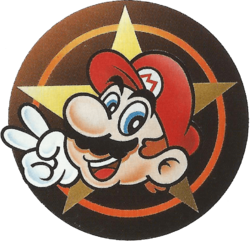(Continue Nav is a required link) |
(new features link) |
||
| Line 22: | Line 22: | ||
''Super Mario Advance'' was a best-selling launch game, and became part of the GBA's Player's Choice lineup as one of the console's first three Player's Choice games (along with ''[[Mario & Luigi: Superstar Saga]]'' and ''[[Super Mario Advance 3]]''). | ''Super Mario Advance'' was a best-selling launch game, and became part of the GBA's Player's Choice lineup as one of the console's first three Player's Choice games (along with ''[[Mario & Luigi: Superstar Saga]]'' and ''[[Super Mario Advance 3]]''). | ||
Refer to the [[Super Mario Bros. 2/ | Refer to the [[Super Mario Bros. 2/New features|New features]] page for differences between the Nintendo Entertainment System, Super Nintendo, and Game Boy Advance version. | ||
{{ToC}} | {{ToC}} | ||
Revision as of 05:26, 24 March 2014
In 2001, Super Mario Bros. 2 received another enhanced remake as part of Super Mario Advance (also containing a remake of Mario Bros). Super Mario Advance was developed by Nintendo R&D2, and represented the first Mario title for the Game Boy Advance.
The Super Mario Advance version of SMB2 includes several new features such as the addition of the new enemy, Robirdo (a robotic Birdo acting as the boss of world three), the addition of the Yoshi Challenge (in which players may revisit stages to search for Yoshi eggs), and an all-new point-scoring system (a first for the game). Graphical and audio enhancements were also added in the form of enlarged sprites, multiple hit combos, digital voice acting, and such minor stylistic and aesthetic changes as an altered default health-meter level, boss-order, backgrounds, the size of hearts, Princess Toadstool being renamed to the now-standard "Princess Peach," and the inclusion of a chime to announce starmen, were also added. The game also included a full version of the original Mario Bros. arcade game from 1983, with updated audiovisuals and Mushroom Kingdom-based enemies replacing the generic creatures of the original (Spinys taking the place of Shellcreepers, for example); this game would be included in all three subsequent Super Mario Advance titles, including Mario & Luigi: Superstar Saga.
Super Mario Advance was a best-selling launch game, and became part of the GBA's Player's Choice lineup as one of the console's first three Player's Choice games (along with Mario & Luigi: Superstar Saga and Super Mario Advance 3).
Refer to the New features page for differences between the Nintendo Entertainment System, Super Nintendo, and Game Boy Advance version.
Table of Contents
- Super Mario Bros.
- Super Mario Bros. 2 (Japan) (The Lost Levels)
- Super Mario Bros. 2
- Super Mario Bros. 3
- Super Mario World
- Super Mario All-Stars
- Yoshi's Island
- Super Mario Land
- 6 Golden Coins
- Super Princess Peach
- Super Mario Maker
- Super Mario Run
- Super Mario Maker 2
- Super Mario Bros. 35
- Super Mario Bros. Wonder
- Princess Peach: Showtime!
